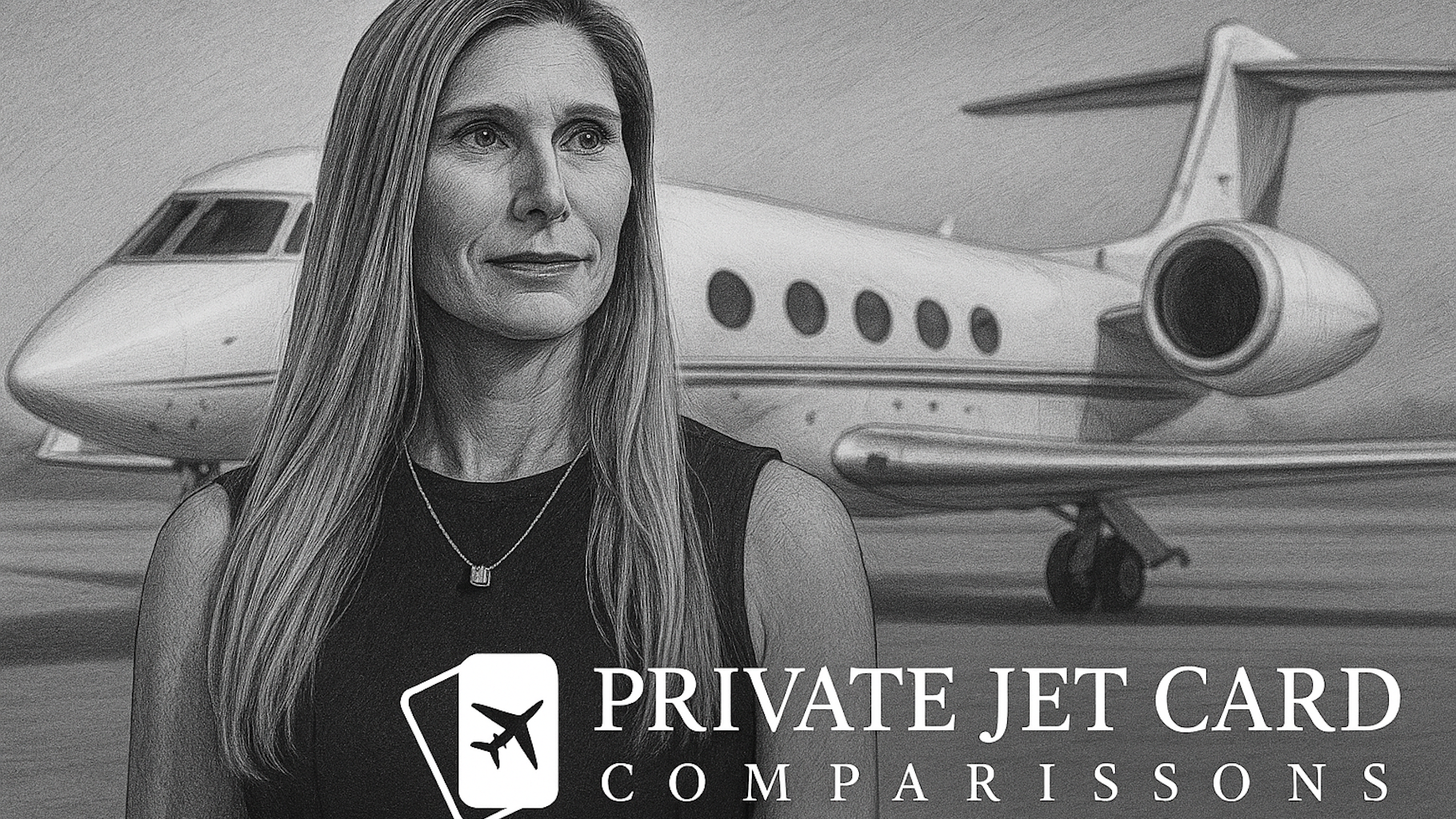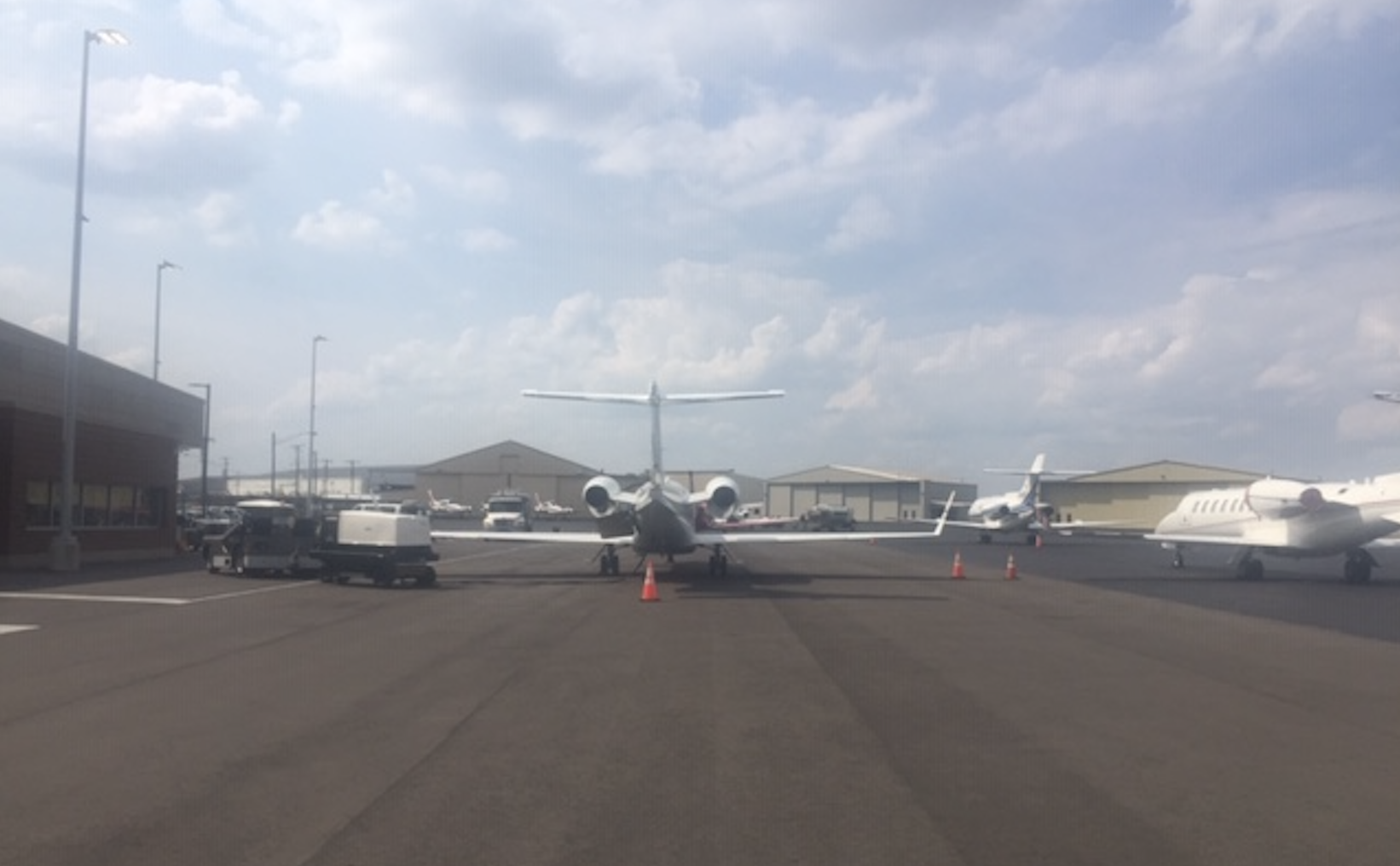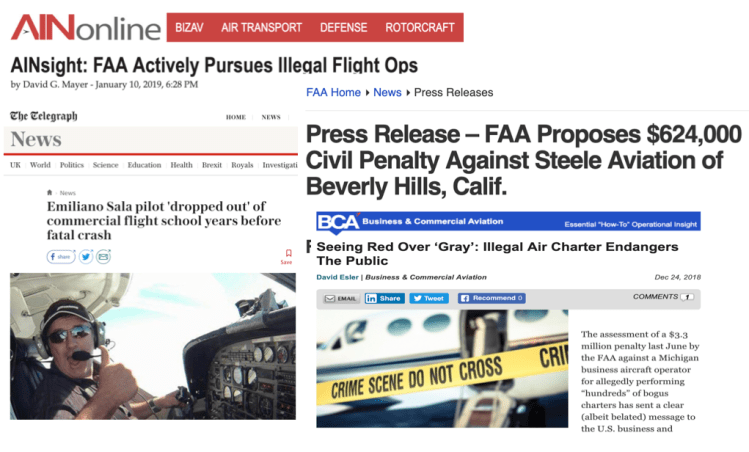

Back in 2016, I was visiting the headquarters of Jet Linx Aviation in Omaha, Nebraska. Walking with its CEO Jamie Walker between a series of meetings, he suggested I write about illegal charters. He said it was a subject he didn’t think was getting enough attention.
To be honest, I didn’t even know what made a private jet charter illegal. And why should the traveling public care?
Illegal operators are able to offer significantly lower prices but at much greater risk
– National Air Transportation Association
Frequent fliers on airlines have all sorts of tricks to save money, like hidden city tickets and nested itineraries. The airlines call them ‘illegal’ as they violate their arcane ticketing rules. Users cost them money. Many say airline pricing structures make these wounds self-inflicted. In other words, savvy buyers save money by simply buying what airlines are selling.
I quickly found illegal charters are indeed a serious issue, sometimes deadly. They also aren’t always apparent, particularly to consumers and even regulators. That’s the scary part.
In January 2019 European soccer star Emiliano Sala died while on a private flight from France to England. It was an illegal charter. He was on his way to sign a multi-million dollar contract.
The aircraft wasn’t flying under an Air Operator’s Certificate (AOC), or FAR Part 135, its equivalence in the U.S. That’s the authority granted by a nation’s aviation oversight certifying the operator and aircraft meets its standards for commercial operations. These regulations are more stringent than if you have a private jet for your own personal use. That would be Part 91 in America.
What’s more, Sala’s pilot wasn’t qualified to fly passengers for compensation and didn’t have the ratings for a night flight. Illegal charters made the mainstream media for a few minutes.
It’s not just in Europe or with small private airplanes. In June, the FAA reported both pilots in a 2018 Dassault Falcon 50 crash in South Carolina weren’t qualified. And in fact, neither was the aircraft, which ran off the end of the runway.
It turned out the aircraft’s braking system wasn’t working properly. A pilot who had flown four flights on N114TD had reported brake system failure to the operator’s director of maintenance.
Industry executives say several other deadly crashes in recent years have signs of possibly being illegal charters.
The Federal Aviation Administration notes, “Air charter operations require a higher level of FAA pilot training and certification, aircraft maintenance procedures, and operational safety rules than pilots who may take family or friends for an airplane ride.”
The body adds, “FAA inspectors perform more frequent periodic checks on air charter companies’ pilots, crewmembers and aircraft than they do on private pilot operations. And charter companies’ crewmembers must undergo regular proficiency checks to maintain their FAA certifications.”
In the past month, there have been a least four industry webinars on the subject. Each included warnings that illegal charters are proliferating. Nearly two-thirds (64%) of attendees for an Aviation Week panel said illegal charter is Very/Often Problematic. Another 31% said these gray market flights are Occasionally Problematic. Only 5% classified these rule-skirting private jet rentals as Rarely Problematic. One expert says 20% of transatlantic charter flights are likely illegal charters.
So why are illegal charters increasing?
Experts say it’s a deadly cocktail mixing operators under financial pressure from the travel downturn and more first-timers seeking alternatives to the airlines or long drives as a risk reduction strategy to avoid COVID-19.
Many of the newcomers, used to shopping by price when booking airline tickets, hotels, and car rentals, assume the airplanes they are flying on are safe and the crews are qualified to fly them.
“The general public makes a lot of gross assumptions. (The pilots must) be trained, the aircraft is just too pretty to not be well maintained, and we all know that’s just not the case. That’s why it’s a safety risk out in the market,” Ryan Waguespack, a senior vice president of aircraft management for the National Air Transportation Association (NATA) told listeners to a recent Aviation Week webinar. He also raised the issue about the rise of illegal charters operating across the Atlantic where properly maintained planes and qualified pilots are even more critical.
Moderator Fred George, a senior editor with the media group, believes, “Charter customers are the ones who are buying into this thing voluntarily. Charter customers looking for the best price are undercutting the legitimate charter operators, and fueling the demand for illegal charter.”
The requirements for a person who owns a private jet for their own use and one certified for charter flights is significant.
Don Wiley, an investigator with the FAA, says for Part 91, there are no ongoing training requirements, no duty limitations on how many hours per day your pilots can fly, no government required maintenance program or manuals, no mandated oversight, and no drug and alcohol testing, just for starters. Pilots flying under Part 135 must have at least 1,200 hours of total flight time, as an example.
There’s also the issue of insurance. Policies written for personal or corporate use aren’t valid for on-demand charters or jet card flights. The premiums for these types of operations is much higher.
Waguespack divides illegal charter into three categories: The careless, the clueless, and the criminal.
“The careless is just a misunderstanding. The clueless is a lack of understanding. The criminal is those that have the intent to skirt the regulations,” he says.
By the way, the audience agreed with George. You are the biggest problem. Over half of those polled (51%) said charter customers are the least likely to report illegal charters.
Kent Jackson, an aviation attorney, says when consumers do report illegal charters, it’s usually by accident. They are actually reporting what they think is price gouging when legitimate operators and brokers quote them market rates. It’s only then, that it becomes apparent that the low-cost private jet flights were illegal operations.
In terms of the careless and clueless, we covered the subject last December in our post, “You might be running an illegal charter (and not know it).”
Aircraft owners can fly their airplanes under Part 91, and then rent them out under Part 135. That’s having your cake and getting to eat it too. You have your own private aircraft and earn charter revenue.
Some want the revenue, but don’t want the added expense of making their aircraft Part 135 compliant. That’s why they will offer ‘friends’ LLC and dry lease arrangements, allowing them to fly on the cheap.
From time to time, you will see the FAA fine offenders when it believes it can prove flights were being operated illegally. In 2018, it proposed a $3.3 million fine against The Hinman Company and $624,000 against Steele Aviation. Earlier this year it proposed a $1.5 million fine against BEL Aviation, accusing it of operating 114 illegal charters between 2016 and 2018.
Wiley says, “We’ve just got done with a case…The PIC (Pilot-in-Charge) was not typed in the aircraft and the SIC (Second Officer-in-Charge) was a student pilot with less than 50 hours. That’s one of the most unsafe things I’ve seen. This stuff goes on. It happens.”
I’ve written about BlackBird’s questionable “Uber of flying” leases. You could book cheap flights and seats in minutes by entering a credit card and clicking the buy button.
What wasn’t disclosed – unless you read multiple agreements containing over 10,000 words – was you weren’t necessarily booking a Part 135 charter. You were entering a Dry Lease. That means you are assuming responsibility and liability for the flight’s operations. If there was a problem, don’t call BlackBird. They’re just a platform. The contract you signed electronically says you understood and agreed to those terms.
Eight months after our story, the FAA released a letter saying it was investigating BlackBird. The company responded by discontinuing the dry leases, focusing instead on being a marketplace for Part 135 operators. Surf Air acquired it in February 2020.
During my original research, I asked then BlackBird CEO Rudd Davis why none of the articles covering his company made mention of the differences between Part 91 dry leases and Part 135 charters. He blew me off saying journalists wouldn’t understand the difference. In the new world of marketplaces like Amazon and eBay, the old language wasn’t accurate anyway, he claimed.
Illegal charters are not easy to catch. Wiley says the FAA does ramp checks. Inspectors query pilots about who has operational control for the flight. In a dry lease, it’s the lessee. In a Part 135 charter, it’s the operator.
How long does a dry lease need to run to be legitimate? There is no stipulation in the rules. Attorney Jackson advises his clients a minimum of one year.
Wiley says when asking flight crew for documentation, it’s a red flag if there are dozens of dry leases. Day leases or even a lease to cover a series of trips are warning signs. Often, he says, it’s the passengers who give the game away by referring to the flight as a charter.
The FAA also provides tips for consumers to spot illegal charter:
Unfortunately, one telltale sign is currently on hiatus. Right now, there is no Federal Excise Tax (FET). Legitimate operators have to collect the tax. As part of the CARES Act, there is a FET waiver through the end of the year.
Wiley says 50% of the violations the FAA finds are intentional. In other words, they fall into the criminal intent bucket, not just a misunderstanding of the rules.
That can include a Part 135 operator flying you for compensation on an airplane that isn’t on its certificate. In other words, it’s not just checking a list of charter operators, it’s ensuring your aircraft is on their certificate.
That means that your specific tail number is on a maintenance program that complies with regulations for commercial charters, something that would likely have prevented the South Carolina crash. In other words, its maintenance issues should have prevented it from being dispatched.
“Sophisticated customers will ask not only to see a copy of the Aircraft Operator’s Certificate but also the D085 (which is specific to the aircraft),” says Jackson.
If you have any doubts, NATA advises, “Ask for copies of the air carrier certificate and for validation that your selected aircraft is authorized for charter use. If an operator is resistant to providing verification, you would be wise to consider another charter operator.” You can also ask for proof of insurance.
NATA recommends calling the operator’s local FAA office to ask about the operator’s safety and compliance record. A list of Part 135 operators, tail numbers on the certificate as of this month, and local FAA office can be downloaded below.
Another way to ensure you are flying with a Part 135 operator, your aircraft has a DO85, and your pilots are current with medical tests, training and other proficiency requirements come from Argus and Wyvern.
The two private companies provide the third-party ratings you see on many operator and broker websites.
You will find most operators and brokers work with at least one if not both. You should request the Argus TRIPCheq or Wyvern PASS report before flying. If the crew changes before your departure, request an updated report.
Argus CEO Joe Moggenberg tells Private Jet Card Comparisons consumers can also subscribe, with annual pricing about $300. Companies that have more specific requirements can get reports customized to their specifications, typically for $1,200 to $3,000.
He says around 90 of the largest Part 135 operators covering over 6,000 aircraft are part of the Argus database. With a couple of weeks’ notice, Argus can prepare a TripCheq for a company where it currently doesn’t have information.
Sonny Bates, CEO of Wyvern, says it offers subscriptions for around $300 per month targeted for brokers. However, it can also provide a custom option for individual UHNW fliers or companies that want to do their own due diligence.
While this subject is now getting more industry publicity, it’s not new. That means just because somebody has been in the industry X years, it is not a Good Housekeeping stamp of approval.
Waguespack remembers in 2017 when he was doing a roadshow, asking members what their biggest concerns and challenges were, illegal charter was at the top of the list. In researching stories, I’ve found articles dating back nearly two decades.
In perhaps the best advice, the NATA website warns, “Legal operators incur relatively high overhead costs to maintain the aircraft, train and test crew members, and stay compliant with FAA and TSA regulations. Illegal operators are able to offer significantly lower prices but at much greater risk.”
